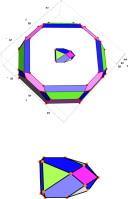A geometric model of growth for cubic crystals: Diamond |
| |
| Affiliation: | 1. Department of Higher Mathematics and Mathematical Physics, Faculty of Physics, Saint-Petersburg State University, Russian Federation;2. Diamond Electronics Laboratory, Institute of Applied Physics — Nizhny Novgorod, Russian Federation;3. Dept. of Physics, St. Petersburg Electrotechnical University, Russian Federation;1. College of Materials Science and Engineering, Hunan University, Changsha 410082, China;2. State key laboratory of powder metallurgy, Central South University, Changsha 410083, China;1. Department of Electrical and Computer Engineering, Michigan State University, East Lansing, MI 48824, United States;2. Department of Physics and Astronomy, Michigan State University, East Lansing, MI 48824, United States |
| |
| Abstract: | 
A mathematical and software implementation of a geometrical model of the morphology of growth in a cubic crystal system, such as diamond, is presented based on the relative growth velocities of four low index crystal planes: {100}, {110}, {111}, and {113}. The model starts from a seed crystal of arbitrary shape bounded by {100}, {110}, {111} and/or {113} planes, or a vicinal (off axis) surface of any of these planes. The model allows for adjustable growth rates, times, and seed crystal sizes. A second implementation of the model nucleates a twinned crystal on a {100} surface and follows the evolution of its morphology. New conditions for the stability of penetration twins on {100} and {111} surfaces in terms of the alpha, beta, and gamma growth parameters are presented. |
| |
| Keywords: | |
| 本文献已被 ScienceDirect 等数据库收录! |
|

